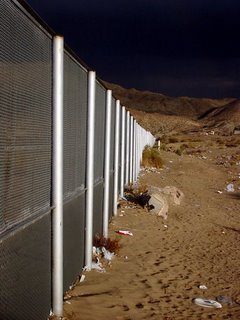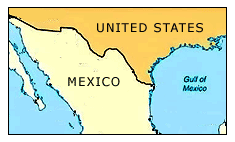


Longer Fence on Mexican Border Debated
 Lawmakers grappled with whether to build a fence along hundreds of miles on the nation's southern border, weighing combating illegal immigration against a costly barrier that alone might not stop migrants. Layered fencing stands on about 75 miles of the 2,000-mile U.S.-Mexico border, mostly in cities like San Diego, El Paso, Texas, and Nogales, Ariz. In an election year fixated on illegal immigration and border security, Congress is considering proposals to put fencing on up to 850 miles on the border, costing billions of dollars. "San Diego was a no-man's land when we built that fence,'' Rep. Duncan Hunter, R-Calif., told a House panel examining border barriers as a way to stem illegal immigration. He said immigrant gang-related murders, drug traffic and human smuggling have dropped dramatically since a fence just south of the city was built in 1996. "The fence did work,'' Hunter said. But Rep. Silvestre Reyes, D-Texas, a former top U.S. Border Patrol official, said fencing could cost as much as $2.2 billion and might not be effective in all areas.
Lawmakers grappled with whether to build a fence along hundreds of miles on the nation's southern border, weighing combating illegal immigration against a costly barrier that alone might not stop migrants. Layered fencing stands on about 75 miles of the 2,000-mile U.S.-Mexico border, mostly in cities like San Diego, El Paso, Texas, and Nogales, Ariz. In an election year fixated on illegal immigration and border security, Congress is considering proposals to put fencing on up to 850 miles on the border, costing billions of dollars. "San Diego was a no-man's land when we built that fence,'' Rep. Duncan Hunter, R-Calif., told a House panel examining border barriers as a way to stem illegal immigration. He said immigrant gang-related murders, drug traffic and human smuggling have dropped dramatically since a fence just south of the city was built in 1996. "The fence did work,'' Hunter said. But Rep. Silvestre Reyes, D-Texas, a former top U.S. Border Patrol official, said fencing could cost as much as $2.2 billion and might not be effective in all areas. "There are, in my opinion, no one-size-fits-all solutions for border security,'' Reyes said. "I think it wastes money. I think it's not a good investment of taxpayer dollars.'' The Border Patrol last year arrested 1.2 million illegal immigrants who crossed into the United States at the Mexican border. But agents estimate that two or three migrants go undeterred for every one who is stopped. Border Patrol senior associate chief Kevin Stevens said fences have stopped, or at least slowed, illegal migrants. But he questioned whether fencing would be effective where there are natural barriers, like mountains or deserts. He wouldn't talk about specific plans to extend the fence to any length. "Can you look the American people in the eye and say this is needed? And that it's the most practical use of taxpayer dollars?'' asked Rep. Elijah E. Cummings, D-Md. "We need an appropriate mix,'' Stevens answered. "It's not about fencing. It's not about Border Patrol agents. It's not about technology. It's about all of those things.'' Critics said little will stop illegal immigration while jobs are so readily available for migrants. The Homeland Security Department recently began cracking down on employers who hire immigrants - many of whom work for cheaper wages and with fewer benefits. But the Bush administration is pushing Congress to approve a temporary worker program that would let illegal immigrants have some legal status.
"There are, in my opinion, no one-size-fits-all solutions for border security,'' Reyes said. "I think it wastes money. I think it's not a good investment of taxpayer dollars.'' The Border Patrol last year arrested 1.2 million illegal immigrants who crossed into the United States at the Mexican border. But agents estimate that two or three migrants go undeterred for every one who is stopped. Border Patrol senior associate chief Kevin Stevens said fences have stopped, or at least slowed, illegal migrants. But he questioned whether fencing would be effective where there are natural barriers, like mountains or deserts. He wouldn't talk about specific plans to extend the fence to any length. "Can you look the American people in the eye and say this is needed? And that it's the most practical use of taxpayer dollars?'' asked Rep. Elijah E. Cummings, D-Md. "We need an appropriate mix,'' Stevens answered. "It's not about fencing. It's not about Border Patrol agents. It's not about technology. It's about all of those things.'' Critics said little will stop illegal immigration while jobs are so readily available for migrants. The Homeland Security Department recently began cracking down on employers who hire immigrants - many of whom work for cheaper wages and with fewer benefits. But the Bush administration is pushing Congress to approve a temporary worker program that would let illegal immigrants have some legal status. Conservative Republicans, particularly in the House, largely oppose such a program, which they view as giving amnesty to criminals. An estimated 12 million illegal immigrants already live in the United States. "As long as illegal immigrants can readily obtain employment in the United States, neither barriers nor increased staffing will discourage millions of impoverished people from crossing our borders annually,'' said T.J. Bonner, president of the National Border Patrol Council, a labor union that represents about 10,500 U.S. Border Patrol agents.
Conservative Republicans, particularly in the House, largely oppose such a program, which they view as giving amnesty to criminals. An estimated 12 million illegal immigrants already live in the United States. "As long as illegal immigrants can readily obtain employment in the United States, neither barriers nor increased staffing will discourage millions of impoverished people from crossing our borders annually,'' said T.J. Bonner, president of the National Border Patrol Council, a labor union that represents about 10,500 U.S. Border Patrol agents.

 Lawmakers grappled with whether to build a fence along hundreds of miles on the nation's southern border, weighing combating illegal immigration against a costly barrier that alone might not stop migrants. Layered fencing stands on about 75 miles of the 2,000-mile U.S.-Mexico border, mostly in cities like San Diego, El Paso, Texas, and Nogales, Ariz. In an election year fixated on illegal immigration and border security, Congress is considering proposals to put fencing on up to 850 miles on the border, costing billions of dollars. "San Diego was a no-man's land when we built that fence,'' Rep. Duncan Hunter, R-Calif., told a House panel examining border barriers as a way to stem illegal immigration. He said immigrant gang-related murders, drug traffic and human smuggling have dropped dramatically since a fence just south of the city was built in 1996. "The fence did work,'' Hunter said. But Rep. Silvestre Reyes, D-Texas, a former top U.S. Border Patrol official, said fencing could cost as much as $2.2 billion and might not be effective in all areas.
Lawmakers grappled with whether to build a fence along hundreds of miles on the nation's southern border, weighing combating illegal immigration against a costly barrier that alone might not stop migrants. Layered fencing stands on about 75 miles of the 2,000-mile U.S.-Mexico border, mostly in cities like San Diego, El Paso, Texas, and Nogales, Ariz. In an election year fixated on illegal immigration and border security, Congress is considering proposals to put fencing on up to 850 miles on the border, costing billions of dollars. "San Diego was a no-man's land when we built that fence,'' Rep. Duncan Hunter, R-Calif., told a House panel examining border barriers as a way to stem illegal immigration. He said immigrant gang-related murders, drug traffic and human smuggling have dropped dramatically since a fence just south of the city was built in 1996. "The fence did work,'' Hunter said. But Rep. Silvestre Reyes, D-Texas, a former top U.S. Border Patrol official, said fencing could cost as much as $2.2 billion and might not be effective in all areas. "There are, in my opinion, no one-size-fits-all solutions for border security,'' Reyes said. "I think it wastes money. I think it's not a good investment of taxpayer dollars.'' The Border Patrol last year arrested 1.2 million illegal immigrants who crossed into the United States at the Mexican border. But agents estimate that two or three migrants go undeterred for every one who is stopped. Border Patrol senior associate chief Kevin Stevens said fences have stopped, or at least slowed, illegal migrants. But he questioned whether fencing would be effective where there are natural barriers, like mountains or deserts. He wouldn't talk about specific plans to extend the fence to any length. "Can you look the American people in the eye and say this is needed? And that it's the most practical use of taxpayer dollars?'' asked Rep. Elijah E. Cummings, D-Md. "We need an appropriate mix,'' Stevens answered. "It's not about fencing. It's not about Border Patrol agents. It's not about technology. It's about all of those things.'' Critics said little will stop illegal immigration while jobs are so readily available for migrants. The Homeland Security Department recently began cracking down on employers who hire immigrants - many of whom work for cheaper wages and with fewer benefits. But the Bush administration is pushing Congress to approve a temporary worker program that would let illegal immigrants have some legal status.
"There are, in my opinion, no one-size-fits-all solutions for border security,'' Reyes said. "I think it wastes money. I think it's not a good investment of taxpayer dollars.'' The Border Patrol last year arrested 1.2 million illegal immigrants who crossed into the United States at the Mexican border. But agents estimate that two or three migrants go undeterred for every one who is stopped. Border Patrol senior associate chief Kevin Stevens said fences have stopped, or at least slowed, illegal migrants. But he questioned whether fencing would be effective where there are natural barriers, like mountains or deserts. He wouldn't talk about specific plans to extend the fence to any length. "Can you look the American people in the eye and say this is needed? And that it's the most practical use of taxpayer dollars?'' asked Rep. Elijah E. Cummings, D-Md. "We need an appropriate mix,'' Stevens answered. "It's not about fencing. It's not about Border Patrol agents. It's not about technology. It's about all of those things.'' Critics said little will stop illegal immigration while jobs are so readily available for migrants. The Homeland Security Department recently began cracking down on employers who hire immigrants - many of whom work for cheaper wages and with fewer benefits. But the Bush administration is pushing Congress to approve a temporary worker program that would let illegal immigrants have some legal status. Conservative Republicans, particularly in the House, largely oppose such a program, which they view as giving amnesty to criminals. An estimated 12 million illegal immigrants already live in the United States. "As long as illegal immigrants can readily obtain employment in the United States, neither barriers nor increased staffing will discourage millions of impoverished people from crossing our borders annually,'' said T.J. Bonner, president of the National Border Patrol Council, a labor union that represents about 10,500 U.S. Border Patrol agents.
Conservative Republicans, particularly in the House, largely oppose such a program, which they view as giving amnesty to criminals. An estimated 12 million illegal immigrants already live in the United States. "As long as illegal immigrants can readily obtain employment in the United States, neither barriers nor increased staffing will discourage millions of impoverished people from crossing our borders annually,'' said T.J. Bonner, president of the National Border Patrol Council, a labor union that represents about 10,500 U.S. Border Patrol agents.
































<< Home